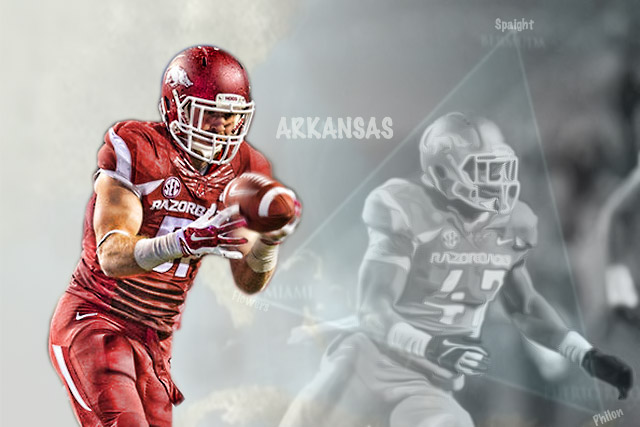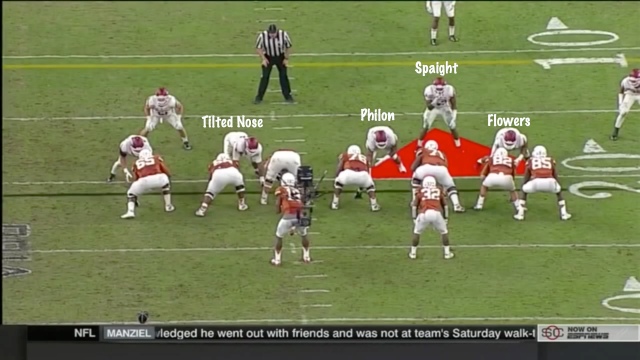Brooks Ellis is capable of replicating Spaight's production for Hogs D
For the University of Arkansas, the 2014-15 season should be retrospectively viewed as a step in the right direction from critics and pundits alike.
Despite a pedestrian 7-6 record, the Razorbacks proved to be a tough out against a host of elite teams — most notably the University of Alabama (14-13) and Mississippi State University (17-10) — while drowning the well-respected Louisiana State University and the University of Mississippi in back-to-back shutouts, 17-0 and 34-0, respectively.
Due to the presence of head coach Bret Bielema, the majority of the shine was placed upon the offensive side of the ball where a carryover from his time as the head man at the University of Wisconsin was most certainly in full philosophical effect.
Just like with his time in Madison, the rushing attack — led by two 1,ooo-yard rushers in Jonathan Williams and Alex Collins — was physical enough to wear down some of the best defenses in the country, while the offensive line, in typical Badger fashion, was billed as the largest in the sport. (Yes, NFL included!)
Arkansas was pretty much in possession of the most physical scheme in the land with the offensive philosophy to support said scheme.
But for those of us who’ve paid close attention to what was going on in Fayetteville, it was the defense that should’ve received the lion’s share of the praise behind three upperclassmen who were among the best the conference had to offer: 6-technique defensive end Trey Flowers, versatile interior lineman Darius Philon and the surprisingly talented weak-side linebacker Matrell Spaight.
While most were aware of the exploits of both Flowers and Philon beforehand, as the duo were on many preseason watchlists, the monster season turned in by Spaight — 128 tackles (10.5 for a loss), one sack, one interception and two forced fumbles — was an immense surprise.
But moreover, it was first-year defensive coordinator Robb Smith’s scheme, and the deployment of his personnel, that propelled the rapid turnaround from an average unit the previous season.
His aptly titled “Bermuda Triangle” deployment of the aforementioned stars was a bit of a genius move, but now with all three headed to the NFL many are wondering if he has the personnel to replicate it.
As it pertains to replacing Spaight, one should look no further to the man who played the entire year right next to him, rising junior Brooks Ellis.
Robb Smith’s Scheme’s Origin
To truly understand what Smith is trying to convey with his scheme, one must hearken back to his time spent under one of the best defensive minds in all of football, former University of Rutgers and Tampa Bay Buccaneers head coach Greg Schiano.
Smith worked under Schiano from 2009-13, at both stops, working various roles: outside LB coach, defensive back coach and defensive coordinator.
His approach is well-rooted in the Schiano way of thinking, which is primarily centered around sound tackling.
As a proponent of a 4-3-based alignment, Schiano’s multi-faceted approach also included a few elements from an odd-front scheme — most notably a tilted, 1-technique nose tackle (defensive tackle lined up slanted between the guard and the center).
The fact that a tilted nose was deployed in that scheme suggests Schiano was in favor of creating favorable matchups for his most prominent players — which were usually a 3-technique, a pass-rushing 6-technique and a weak-side linebacker.
These three players were normally aligned to the weakside of the formation which essentially makes the open side the strength of the defense.
The last incarnation of that was played by Pro Bowl 3-technique Gerald McCoy, the oft-injured Adrian Clayborn (defensive end) and the uber-athletic Lavonte David (weak-side LB), in Schiano’s last stop in Tampa.
Here’s a look at Schiano’s bunch in Tampa with the aforementioned players — including that tilted 1-technique.
Smith has adopted a lot of the same elements as Schiano: a nice mix of man- and zone-based principles, creative fabricated-pressure schemes and the same way of freeing up his best players to make plays.
His version of the “Bermuda Triangle,” coined by Texas Bowl analyst Brian Griese, unearthed the 6’0″, 232-pound Spaight as he undoubtedly benefitted from the exploits in front of him by Flowers and Philon.
But his understanding of offensive concepts, his physicality and instinctiveness was all his own.
Schiano would be proud of this alignment as it’s right out of his playbook; Arkansas must replace all three players in this alignment.
Spaight’s sideline-to-sideline ability was only superseded by his physicality at the point of attack; his skill set fit well with what was required from him by Coach Smith.
Just look at the type of splash plays Spaight unleashed on the opposition; Ellis has those same tools and more.
Brooks Ellis’ Skill Set
Fayetteville’s own, Brooks Ellis arrived at “The Hill” as a 3-star inside linebacker prospect in 2013. In layman’s terms, an inside linebacker is the name commonly given to any off-the-ball linebacker who is aligned in the middle of the defense — meaning there’s no such thing as an inside linebacker in an even-front defense.
So these type of players are usually the least athletic of all the linebackers with the “Sam” and “Will” having to be the better athletes; Ellis doesn’t fit that particular mold. He reminds me of now Philadelphia Eagles weak-side linebacker Kiko Alonso who was once miscast as an inside player, as well.
But playing Alonso, or Ellis, on the inside takes away from their innate playmaking ability and athleticism.
Former University of Oregon product Kiko Alonso sets the standard for weak-side linebackers in the NFL
In fact, I’d be willing to venture out and say that Ellis is an even better athlete that Spaight, or at the very least equal to, while being bigger at 6’2″, 244 pounds.
In actuality, the 6’2″, 240-pound Josh Williams is the best option at “Mike” LB, proving such when he filled in for an injured Ellis against the University of Georgia and contributed a whopping 14 tackles against a very physical offense.
Williams does a fantastic job of disengaging from blocks, while that’s not necessarily Ellis’ strong point. However, Ellis is money in space and understands zone drops and man-to-man coverage.
Playing him on the weakside will only provide him with more opportunities to make instinctual plays.
Case in point: Ellis showed his ability to navigate in area coverage on this interception of Mississippi State quarterback Dak Prescott.
In zone coverage, you have to possesses the discipline to not float in someone else’s quadrant, and you have to have the quickness — which is really an innate understanding — to make a difference.
One thing Ellis could improve upon is with his open-field tackling. He has a tendency to tackle high, at times, which results in missed tackles after he’s correctly read and diagnosed a play.
Other than that, there’s not much to dislike about Ellis’ set of skills. He’s a run-and-chase ‘backer who has a keen understanding of offensive concepts with the prerequisite athleticism to support it all; he would fit perfect as the linchpin in the new “Bermuda Triangle.”
Now all that’s left is to figure out who takes over in Flowers and Philon’s stead.






